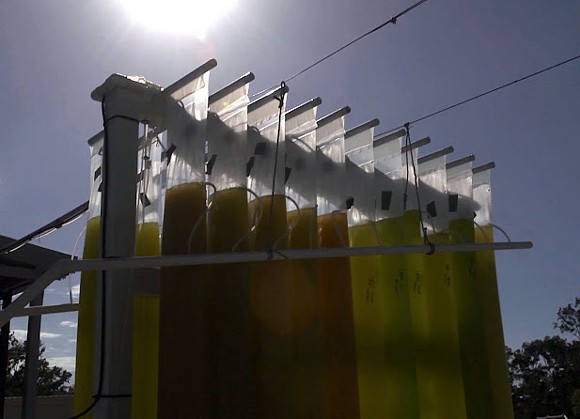While OriginOil’s main focus is extracting oil from algae for use in making biofuels and other products, the company has just announced promising test results for a chemical-free process of using algae for the cleanup of “produced water” from oil and gas operations.
 Algae bags at test site. Photo courtesy of OriginOil.
Algae bags at test site. Photo courtesy of OriginOil.
To understand it a little better, the U.S. Department of Energy explains that, “Produced water is water trapped in underground formations that is brought to the surface along with oil or gas. It may include water from a reservoir, water injected into the formation, and any chemicals added to the production and treatment processes. Produced water is also called brine or formation water.”
Produced water is considered an industrial waste and a hazard to people if it gets into the drinking water. Besides a high salt content, the energy department says that produced water can containing varying degrees of:
- Oil and grease.
- Chemical additives used in drilling and operating a well.
- Naturally occurring radioactive materials.
- Various natural inorganic and organic compounds.
OriginOil said that its researchers have been able to clarify water samples from a Texas oil well carrying heavy concentrations of dissolved organics, known as frac flowback.
Riggs Eckelberry, president and CEO of OriginOil, explained the process in an update last week, saying:
Flowback is what comes out of a well when you inject a bunch of water. Done right, the water comes back up heavy loaded with petroleum, and in the case of gas, with the chemicals that were sent down.
So I watched the team run this black water through our algae appliance test unit, and lo and behold, the petroleum went to the surface. On that day (April 3rd), we learned that what we developed for algae harvesting seems to work great for cleaning that injected water.
It makes sense. After all, petroleum is mostly fossilized algae. And it often comes out of the ground dissolved in a large amount of water, which is the same problem we solve in algae harvesting.
So what does this do for our business model? It’s like baking soda. When Arm & Hammer found more uses for it, they made the backing soda so much more valuable. We remain focused on algae harvesting, while finding other uses that make it much more valuable. First by proving it works, then by licensing it out. The petroleum industry needs the help to clean up all that water.
The U.S. Energy Department says that, “Produced water is by far the largest volume byproduct or waste stream associated with oil and gas exploration.”
Approximately 21 billion bbl (barrels; 1 bbl = 42 U.S. gallons) of produced water are generated each year in the United States from nearly a million wells. This represents about 57 million bbl/day or 2.4 billion gallons/day.
Early in the life of an oil well, the oil production is high and water production low. Over time the oil production decreases and the water production increases. Many older U.S. wells have a (water-to-oil) ratio of over 50:1.
At some point, the cost of managing the produced water exceeds the profit of selling oil. When this point is reached, the well is shut in.
BlueTech Blog – an open forum for discussion on water issues – explains what usually happens to the produced water when a well is operating, saying that:
Traditionally, produced water is stored temporarily in containment pits. It is then handled one of two ways: either trucks haul the water to treatment facilities, or the water is evaporated in pits and then the dry dregs are trucked to landfills or designated dumping sites.
During hydraulic fracturing, a line of trucks brings clean water to use in the fracturing procedure. After the fracturing is complete, another line of trucks hauls the contaminated water to treatment facilities. Hauling water to the site just to haul more water out later is inherently inefficient compared to methods that promise to keep the entire treatment process on-site.
Technologies – including forward osmosis and self-contained evaporation – are intended to please energy companies and the public alike.
Energy companies win because water is treated on-site, saving on transportation costs. The public and the environment win because water emerges from treatment clean and reusable (some is so clean it can be reintroduced into the rivers from which it was extracted).
These technologies, each already producing profits, make environmentally sound water treatment affordable for energy companies faced with narrowing margins.
Eckelberry at OriginOil believes that algae can have a strong marketable use in this area.
“The water itself must be cleaned. Our chemical-free, high flow and low energy process holds promise for the billions of gallons of water used daily in the oil and gas industry,” said Eckelberry.
“Energy companies pay between $3 to $12 to dispose of each barrel of produced water, implying a potential world market value between $300 billion and $1 trillion per year. It seems that in addition to helping create the renewable energy market of the future, we may add value to a massive existing market,” added Eckelberry.
Reader comments and input are always welcomed!